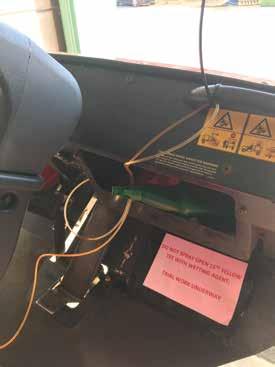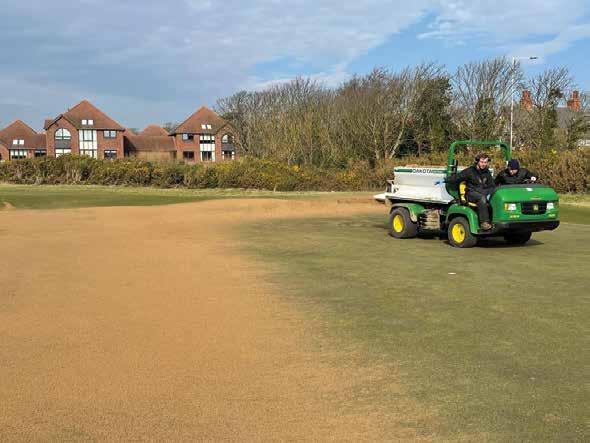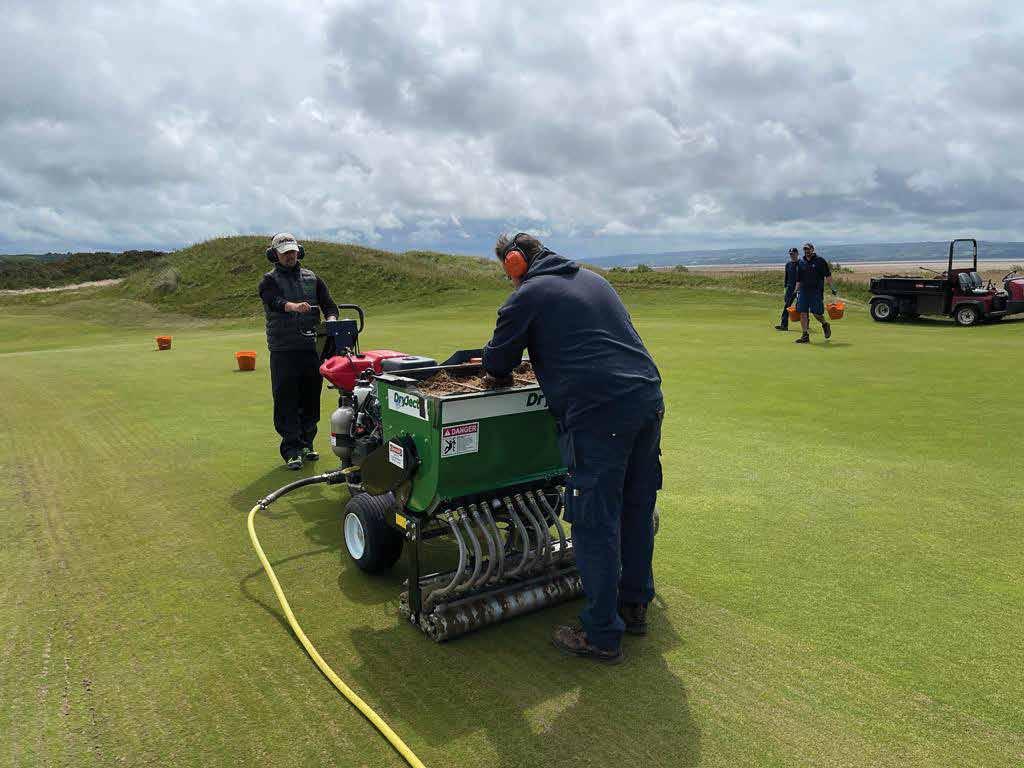
4 minute read
Hand watering is an additional water usage efficiency

Bunkers

The eighty-two bunkers all are constructed with revetted faces; fifty being remodelled by the team over this last winter. They are sprayed with total weedkiller, then routinely scorched with propane gas burners to keep them ‘clean’ and free from weeds and grasses. The sand (sourced from the course) is currently brushed up the faces with smooth rakes for the members, which helps the ball roll into raked centres. For the tournament, it is planned that the sides will be levelled, which will make the bases a little more punishing for the professionals.

ranges from daily, weekly, monthly, and usually quarterly programmes, and sometimes yearly, which all help everyone in the business understand where they are travelling. Bledge’s office walls are covered in a myriad of wallcharts (which he has dotted in strategic positions).
Bledge explains, “I have a magnetic board on duty for the week. As any manager will tell you, the weather is crucial to everything, so I look on my weather app. and write that up on the board. Once those items are logged, I can begin to programme what we need to achieve agronomically, from cutting regimes to dressings and applications of products. Lastly, I input my personal diary which helps me make sure I know where I must be at any given time or day, whether that be attending the many club meetings or my husband/dad duties!” laughed Bledge. He is the first to admit that all this information is ‘old school’, but as he could testify ‘it works’. “I communicate to the team verbally in the morning or as the day progresses and then my deputy and/or senior greenkeepers pick up the baton with the team for the rest of the day.”
Machinery
Royal Liverpool’s capital expenditure programme for machinery replacement is on a rolling yearly basis. In this way, the club is not committed to any one manufacturer or fleet deal. “I can outright purchase annually what I need,” explained Bledge, “as it becomes available on the market. That way, we get the most up to date equipment as opposed to having to wait years for a finance deal to expire before we can start again. It works extremely well, and my fleet is always being refreshed with the best on offer regularly.” Bledge was rightly quick to praise his mechanic, Phil, who maintains this impressive armada of equipment, always keeping it in tip top condition.
Bledge runs a mixture of diesel, petrol, hybrid and all electric machines, and confesses that he would like more electric once he has developed the infrastructure to support an all-electric fleet. The maintenance facility has a mixture of red, green and yellow equipment, but stand out pieces are his Toro triplex all electric 3370s which he uses for greens, tees, surrounds and approaches. Interestingly, I asked about his ratio of using hand mowers and using triples on cutting greens, “We usually use triples 75% of the time but reduce the frequency leading up to events, favouring hand cutting. Leading into The Open, we will obviously drop out the triples and go 100% hand mowing with our all-electric Toro flex mowers.” Explained Bledge, “As we approach the event, we will increase some of our fleet numbers, as an example from six hand mowers to fourteen (we need six teams of two to cut each day, two being spare), fairway mowers from three to eight, utility vehicles seven to fifteen and triple mowers from three to six. The extras are being kindly donated from John Deere and Toro, and each manufacturer will be supplying a mechanic to help Phil keep everything sharp and operational.”

The devil is in the detail
As turf nerds, we all like to know a little data around benchmarking, especially for a Championship. Bledge informed me the height of cut on the predominantly bent greens are currently 4.5mm and will be dropped to tournament height a few weeks leading into the event. The R&A’s goal tends to be around 10 feet 6 inches on the stimpmetre, of course this is wholly dependent on moisture levels and prevailing weather conditions. To achieve this, the team will not be planning on excessive rolling, but instead favouring hand mowing single cut, double or triple cut to achieve the desired results.


Collars and approaches are currently at 7mm, and fairways are currently cut at 11mm but will most likely be reduced to 10mm for the event. Roughs are cut at two inch and deeper rough cut at four inches. As we discussed all things cutting heights, Bledge hinted that wouldn’t it be amazing if heights of cut could be more uniform at around 7mm or 8mm throughout the course from tee to approach in the future (watch this space for future update)?

The greens have been dry jetted four times over the last twelve months, with the help of Ken Siems; with shallow sand injected over deep injecting, as the organic levels are better deep down. It’s all about firmness, with Clegg hammering at 115 gravities now and The R&A will be hoping for significantly greater firmness than that for the Championship. Bledge plans to dress greens once more before the tournament, but have been applying approximately two hundred tonnes a year historically which has helped.
Sustainability
Obviously, all turf managers understand their responsibility for sustainability and environmental awareness, and Bledge and his team are no different. The club has already gained it’s GEO certification, but the team have not rested on their laurels in driving even more great environmental projects recently. One such project is sand harvesting from site.
Bledge explained, “We use approximately 3,000 tonnes of sand every year for our topdressing programmes and bunker sand topping up.” He went on,” We dress greens, collars and approaches, tees and fairways regularly and so get through quite a bit in a year! Not only would it cost the club a fortune to buy all that sand, but it would cause an impact on the environment, hauling all this material around the country to get it to us.” As well as using harvested sand from the golf course, the team use any waste material gained from around the course when conducting remodelling works (primarily bunker revetting works) and re-use once it has composted down. “We use this for all our divoting and it’s another great example of using what we already have on site.”

Water consumption is very much a sensitive issue when it comes to turf maintenance. This has been compounded over recent years with drought warnings on the increase up and down the country.










